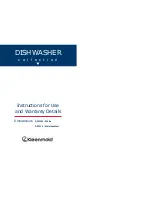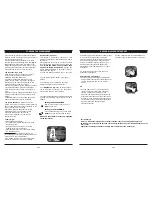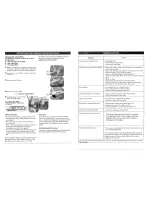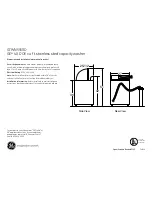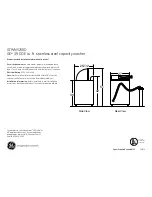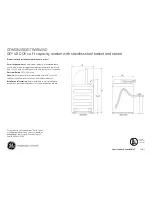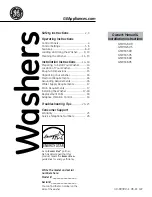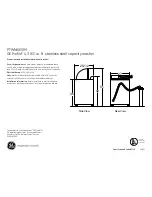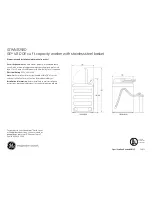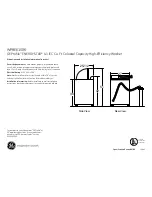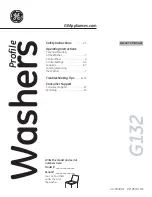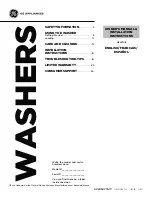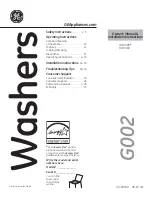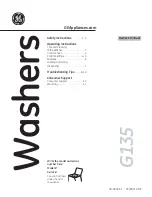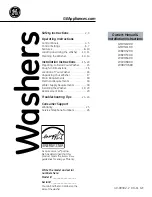
• 6 •
Rinse aid is necessary as it avoids stains on the
dishes and makes drying easier.
IMPORTANT ! Only use products intended for
dishes and NOT detergents intended for hand
washing !
Filling and adjusting the rinse aid container
(Fig. 5-6) :
Put the door in a horizontal position when
filling the container and unscrew the cap in the
door counter clockwise.
Fill to just below the adjusting lever.
If the product overflows on filling, remove the
excess with a sponge to avoid any foam
forming.
If you experience stains or bad drying after
several cycles, you may adjust the dosage using
the selector :
Soft water : level 1 to reduce the dose
Hard water : level 3 to increase it.
For child safety :
Dishwashing detergent and rinse aid should be
treated as poisons and stored where they are
not accessible to children.
ADDING RINSE AID
• 7 •
The water softener must be adjusted correctly
to ensure no streaks after washing and drying.
Your dishwasher is fitted with a water softening
system that operates using regenerating salt.
You must set the water softener according to
the hardness of the water in your area.
➀
➀
-
Measuring the water hardness
To do this:
contact your local water supplier to
find out the water hardness level
OR
measure the water hardness at the tap
using the “Aqua-test” testing strip supplied
with your dishwasher and refer to the table
below to find out the setting to select
according to the water hardness.
Hold down the “Heavy wash” button and turn
the Programmes knob: the display then shows
the water softener setting.
The display shows the water hardness according
to the table below.
To change the setting, turn the Programmes
knob while holding down the “Heavy wash”
button.
When the machine is first switched on, the
setting is 10°F>25°F (displayed as
).
You must fill the salt reservoir with water
before using the machine, even if the water
softener setting selected does not require
any regenerating salt.
If you move house and take the
dishwasher with you, you will need to
check the water hardness and adjust
accordingly.
For good wash results it is very important
to set the dishwasher to the correct level
of water hardness and to set the correct
level of rinse aid (see page 6)
Ca
③
③
Filling the regenerating salt reservoir
You must fill this, with water just before
starting your first wash then add the salt:
Filling with salt is essential to obtain a
good
wash with no streaks.
The salt regenerates
the resins, which soften the water by removing
its limestone content unless the water is already
sufficiently soft (see “Adjusting the water
softener”).
ADJUSTING THE WATER SOFTENER
➁
➁
-
Setting on the control panel
Salt
required
0 - 10°F
10 - 18°F
18 - 25°F
25 - 40°F
40 - 55°F
55 - 70°F
NO
YES
YES
YES
YES
YES
Water softener
setting
Water
hardness
Testing
strip
> 70°F
YES
Never put
detergent in
this reservoir:
this will ruin
the water
softener.
Salt reservoir
- Unscrew the salt reservoir’s stopper and
remove it.
- Use the funnel to introduce the salt.
available from the after-sales department
under reference : 31X3964.
- Fill the reservoir with
regenerating salt
specially designed for dishwashers.
- On the first time, add water until it
reaches the edge of the reservoir.
- Screw the salt reservoir’s stop back in fully.
Do not use kitchen salt.
Should any regenerating salt overflow
when filling, we recommend that you
remove the loose salt crystals to avoid
oxidising the tub.
SAL
T
Protection against water damage :
Your machine is equipped with systems that
protect you from flooding.
- Anti-overflowing mechanism. This system
activates the waste pump if the water level in
the tub reaches an abnormal level.
- Anti-leakage device. This system interrupts the
water supply if a leak is detected underneath
the machine.
If one of these mechanisms is started, contact
the after-sales service to put it back into
working order.
Your machine is equipped with a anti-
bursting pipe.
Evacuating waste water (Fig. 3)
Connect the waste pipe
A. Either to the ventilated siphon. The waste
pipe must be free in the siphon and should
be no deeper than 20 cm.
B. Or on the sink siphon. Be careful not to
forget to remove the siphon cover.
Be careful to fix the waste pipe down with a tie
to avoid any flooding. In any case, the end of
the pipe must be between 60 cm and 1 m high.
Avoid folding the pipe when installing.
- Horizontal drain lines should not exceed 5 m
length.
- Ensure that the drain hose is fully extended
and not restricted in any way.
NOTE : Do not connect drain hose directly to a
waste disposal unit as blocking with food
waste will occur.
Connecting to the power supply :
You should use an earthed plug to connect to
the power supply. In case of a direct connection,
the main switch terminal should be at least
3 mm apart.
The electric plug should remain accessible. Do
not use an extension lead or multiple plug.
• We cannot be held responsible for any
incident caused by the machine being badly
earthed.
In any case, the machine must be fitted in
compliance with the applicable regulations in
your state as well as any extra instructions from
the Electricity Company. The machine’s approval
and model are indicated on the sticker fixed to
the left-hand side of the door. The machine
must be turned off when connecting to the
electric circuit.
Replacing the electric lead
WARNING : In the interests of safety, the
electrical supply lead should ONLY be replaced by
the manufacturer’s after-sales staff or a similarly
qualified person.
INSTALLATION CONTINUED
Ca
Ca
Ca
Ca
Ca
Ca
Ca
Summary of Contents for DW21 X
Page 9: ......

